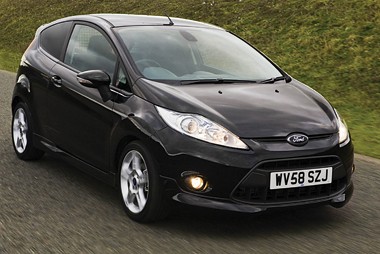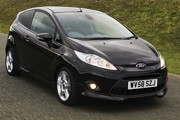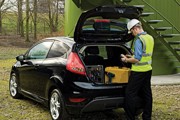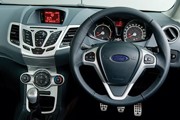Review
There is an intrinsic and fairly obvious problem with small vans which prevent them from being any bigger than a niche market in Britain’s LCV parc – there isn’t much room in the back.
It’s a great pity because for sheer driving enjoyment, you can’t get any better than a vehicle of this size. Yes, we know van driving isn’t supposed to be fun but come on, everyone deserves a bit of amusement in their working lives, don’t they?
For any fleet manager who cares about his or her staff – and doesn’t need more than one cubic metre of space in a commercial vehicle – a new model has just gone on sale which is guaranteed to put a big grin on the face of any driver.
The new Ford Fiesta Van tested here not only looks fantastic but it handles like a dream and – more importantly for our readers – has rock bottom running costs.
I’m not often this effervescent after testing a new commercial vehicle but, having driven the Fiesta Van at its launch in Birmingham, I’ll come out and say it now – the small van sector has a very definite new leader of the pack.
At the launch, Steve Kimber, Ford of Britain’s commercial vehicles director, said: “Fiesta Van is a main player in
the car-derived van market with around 25% of all sales. We expect to build on this as more and more of today’s businesses look to keep their costs under control.
“The van model was an integral part of the new Fiesta product plan and its superior quality really shows. Being competitive has never been more relevant and that’s why Fiesta Van,
with the range-topping SportVan, is a great addition to our 2009 line-up.”
The new Fiesta Van is available in three versions: Fiesta Van, the new Trend and SportVan, with prices rangng from £9,025 for the 1.25 Duratec 82bhp petrol to £10,780 for the SportVan 1.6 TDCi 90bhp with diesel particulate filter.
The Trend is aimed at image-conscious businesses who may be delivering small packages, transporting compact equipment such as meter reading tools or for the site engineer who does not need a large capacity for carrying tools.
The new van is available with a choice of engines: 1.25-litre 82bhp Duratec 16-valve petrol unit and a 1.4-litre 68bhp Duratorq TDCi turbodiesel.
The top-of-the-range 1.6-litre 90bhp TDCi turbodiesel is standard in the Fiesta SportVan. Both diesel engines are built at Ford’s plant at Dagenham, Essex.
The petrol engine has combined fuel consumption of 49.6mpg and CO2 emissions of 133g/km. Both diesel engines have a combined fuel consumption of 67.3mpg and CO2 emissions of 110g/km.
Base models feature as standard dual airbags, ABS brakes, electric windows and mirrors, radio and CD with MP3 connection, four speakers and steering wheel-mounted controls and an adjustable steering column.
Trend models add front foglights, body-coloured, power folding, heated door mirrors, automatic wipers and headlamps, auto dimming rear view mirrors, driver’s seat lumbar support and heated front windscreen.
SportVan also has a body-colour sports aero kit including high intake front grille, rear bumper and rear spoiler, 16-inch five-spoke sports alloy wheels, Bluetooth hands-free and voice control, including multi-function display, air conditioning, sports front seats, leather trimmed steering wheel, rear spoiler, alarm, sports-tuned suspension with lowered ride height, ESP/traction control and driver’s knee and side airbags (head and thorax) and active head restraint.
Behind the wheel
Our March edition featured a first drive of the Fiesta SportVan thanks to an invite from Ford to test the vehicle on its test track at Dunton in Essex.
At that time I hadn’t seen the standard version of the van and wondered whether it could look as good as its glitzy brother.
In my full test drive on the open roads around Henley in Arden, it soon became obvious that even without all the bodykit, the more prosaic examples still look a million dollars with those slash-cut headlamps and jaunty stance.
My only reservation is that there is absolutely no plastic padding round the van – and knowing van drivers as I do, the Fiesta Van is likely to get a few knocks and scrapes along the way, which could prove expensive to patch up. This van has certainly grown in comparison with the older models – it looks almost as big as a Focus from the outside. And climbing aboard, it’s obvious where the extra room is.
For although there is still only one cubic metre of load volume in the back, there is acres of legroom upfront, more than enough for a six-footer-plus like me.
In the rear end there is a standard half-height bulkhead which can be extended upwards for a modest fee of £100 while four load-lashing hooks keep things in place.
The rear screen is see through, which means potential thieves will be able to glimpse what’s inside.
But as the cargo in this van may well include a salivating guard dog, maybe that won’t be a problem.
I tested both standard and Sport models and that familiar TDCi diesel unit fires up smoothly and surely, while out on the road this van sticks to the corners like glue, with nicely-weighted power steering that allows plenty of feel.
The standard output of 68bhp doesn’t sound a great deal but
it is delivered in a lively way that doesn’t make the van feel under-powered.
While most drivers would like a Sportvan model, I’d have to say it won’t suit most fleet purposes.
As our test day was limited to shortish drives we didn’t manage our own fuel economy test, but if the official figure is 67.3mpg,
we’d expect real-life figures in the high fifties, which is great in anyone’s book.
Verdict
As stated earlier, I fell in love with this van at first sight. Great looks, a great drive and low running costs which will guarantee a smile on both the driver’s and fleet manager’s faces. It’s going to be a definite front runner for a Fleet Van Award.



















